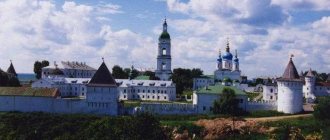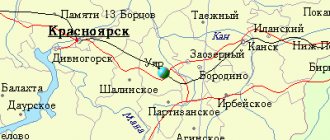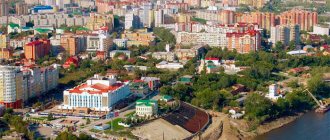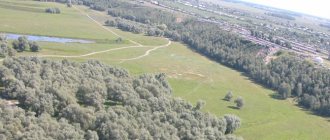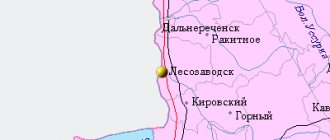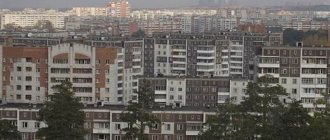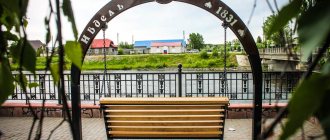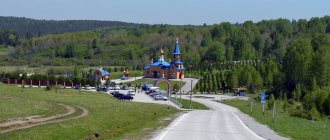General information and description of Novokuznetsk
Novokuznetsk is a city located in the Kemerovo region of the Russian Federation. It has the status of the administrative center of the Novokuznetsk region. The population of the city of Novokuznetsk is just over 549 thousand inhabitants, data from 2013, it is the largest city in the region in size. The city is located on two banks of the Tom River, which flows in Western Siberia. The city has a well-developed metallurgical and coal mining industry, which makes it the largest in these areas of Russian centers. This city is among the top 5 dirtiest cities in the Russian Federation in terms of environmental indicators. The city's birthday is celebrated on the first Saturday in July. We can say that the city is one of the oldest cities founded in Siberia. The date of its foundation is approximately 1617 - 1618. The center of the city from 1620 until almost the end of the eighteenth century was the Kuznetsk fort; its location was on a hill on the right side of the Tom River. The city also has two honorary awards: the Order of the October Revolution was received on July 1, 1981 and the Order of the Red Banner of Labor was received on February 4, 1971.
NOVOKUZNETSK
NOVOKUZNETSK, a city in Russia, in the south. parts of the Kemerovo region, the center of the Novokuznetsk district. The largest city in the region: us. 549.6 thousand people (2012). Located on the river. Tom (pier) at the confluence of the Aba and Kondoma rivers. Railway node The Kemerovo – Leninsk-Kuznetsky – Novokuznetsk – Mezhdurechensk highway passes through N. Airport.
Novokuznetsk. Transfiguration Cathedral. 1792–1801, 1822–30.
Novokuznetsk. Cinema "Kommunar". 1933. Architect M. Kassel.
The oldest settlement on modern territory. N. arose in April. - May 1618, when a detachment under command. O. Kharlamov-Mikhalevsky, M. Lavrov and O. Kokorev on the right bank of the river. A small winter hut was founded in Tom, which received the name. Kuznetsk fort. In the summer of 1620 at hand. T. S. Bobarykin and O. G. Anichkov built a fort on the site of the winter hut; after 1620 a permanent garrison was stationed here. Since 1622 the center of the county. All R. 1670s the fort was a tree. fortress with 8 towers. Until the beginning 18th century was a border outpost of Rus. state in South. Siberia, repeatedly repelled attacks by the Kyrgyz, Tomsk and Kuznetsk Tatars, Teleuts and Dzungars (1624, 1633, 1635, 1638, 1640, 1648, 1665, 1667, 1673, 1675, 1682, 1700, 1709). In 1682, in one of the most significant defenses. During the battles near the Kuznetsk fort, the combined forces of the Tuvans and Kyrgyz were defeated. Since 1689 the city of Kuznetsk. County town of Siberian (1708–79) and Tobolsk (1796–1804) provinces, Kolyvan region. (1779–83), Kolyvan province. (1783–96). In 1717, the first bastion-type tree-earth fortress beyond the Urals was erected in Kuznetsk (after 1750 the wooden fortifications fell into disrepair). In 1799–1820 in Kuznetsk in connection with a possible war. under the threat from China, a stone fortress was erected (after 1846 it was transferred to civilian jurisdiction, partially turned into a prison; now the Kuznetsk Fortress museum). District (1804–22, 1898–1924) and district (1822–98) city of Tomsk province. At 19 – beginning. 20th centuries handicraft and trade activities developed (annual fairs were held since 1891). In 1913, in connection with plans to create a metallurgical district in the vicinity of the city. The enterprise began construction of a railway (constant traffic along the Kuznetsk - Kolchugino line was opened in 1926), in 1914–15 on the left bank of the river. Tom (opposite Kuznetsk) a village was formed. Garden-city. In March 1918, an owl was installed in the city. power; fell in July as a result of the Czechoslovak Corps uprising of 1918. In the summer - autumn of 1918, the city was under the control of the Provisional Siberian Government, then the Ufa Directory (Nov. 1918) and the "Omsk Government" (Nov. 1918 - Dec. 1919). As a result of the uprising of the soldiers of the Kuznetsk garrison on December 2, 1919, the Soviet Union was restored. power. On December 12, 1919, a detachment of Altai partisans G.F. Rogov and I.P. Novoselov entered Kuznetsk and carried out mass executions of opponents of the Owls. authorities in the city. At the end of December, regular units of the Red Army entered the city. Regional center of Tomsk province. (1924–25), district (since 1925) and district (1925–1926) center of the Siberian Territory (1925–30), West Siberian Territory (1930–32). In 1929, under the direction of I.P. Bardin began construction of a metallurgical plant. plant near the village Garden City (launched in 1932; now part of the Evraz United West Siberian Metallurgical Plant enterprise). In 1929 Sad-gorod received the status of a workers' village, and in 1931, together with several surrounding villages, it was transformed into the city of Novo-Kuznetsk. In 1932, the cities of Kuznetsk and Novo-Kuznetsk were united into the city of N. Regional center of the West Siberian Territory (1932–37), Novosibirsk Region. (1937–43), Kemerovo region. (since 1943). In 1932, railway traffic was opened. line Novokuznetsk - Kandalep. In 1932–61 it was called Stalinsk. After the start of Vel. Otech. During the war in 1941, a metal structures plant (now Kuznetsk Metal Structures) was evacuated to Stalinsk from Dnepropetrovsk. The 1252nd Infantry was formed in the city. Regiment of the 376th Kuzbass Infantry. divisions, department ski battalion (both in 1941), 237th Piryatinskaya rifle. division (1942), workers of the Kuznetsk metallurgical plant. plant collected St. 4 million rubles for the construction of the Kuznetsk Metallurg tank column (1943). In Jan. 1943 The aluminum plant was launched (now RUSAL Novokuznetsk). In 1952, permanent railway traffic was opened. line Stalinsk - Barnaul, in 1959 - Stalinsk - Abakan. In 1964, the West Siberian Metallurgical Plant was launched. plant (now part of the Evraz United West Siberian Metallurgical Plant enterprise).
In the old part of the city (the first regular development plan for Kuznetsk was approved by Empress Catherine II in 1786) the following were preserved: baroque-classical. Spaso-Preobrazhensky Cathedral (1st floor – 1792–1801; 2nd floor – 1822–30; stone fence with gate – 1832–33), former buildings. Kuznetsk Treasury (1780, architect Pochekunin; the treasury was located in 1799 – 1920s) and Kuznetsk School, distillery; residential buildings of the 18th–19th centuries. from the merchant mansions (the house of A.E. Fonarev is now a branch of the Kuznetsk Fortress museum); as well as a protected grove of river black poplars (Topolniki). Intensive development of the left bank part of the city began according to the 1931 plan in connection with the construction of the Kuznetsk Metallurgical Plant. plant (1929–1932; project by the American company “Frain”; administration building on Pobedy Square, architect A. D. Kryachkov): 3–4-storey buildings in the constructivist style (1929–34, German architect E. May), Siberian metallurgist. institute (now the Siberian Industrial University), the Kommunar cinema with a semicircular rotunda (German architect M. Kassel; both 1933, in the style of constructivism), the Palace of Culture and Technology of the Novokuznetsk Metallurgical. plant (1936, architects E. Ya. Umansky, K. Ya. Likher). In 1934–1936, the right and left banks of the river. Tom are connected by a bridge. In the 2nd half. 1930s – 1950s (according to the plans of architects B. E. Svetlichny, G. M. Slepykh and others) new centers were created. highways (Kurako, Metallurgov and Bardin avenues fanning out from the railway station) and squares (Teatralnaya, Cosmonauts, etc.), Center. a park of culture and recreation with porticos, fountains and sculptures. In the style of owls. neoclassical built: numerous. residential buildings, that is. degrees that determine the appearance of N. (on Kirova Street, 1936–39, architects I. A. Golosov, F. F. Ananyev and others; on Metallurgov Avenue, 1941, 1947–55, architect N. A. Brovkin; etc.), department store (1938–41, architect P.I. Oturin; completed in 1952–56), hospital town (1948–52, architect S.I. Korotkov), Palace of Culture of the aluminum plant (1956–58 , architect L. V. Luzhbin). The embankments of Aba (residential buildings 1949) with a bridge across the river (1952–1953, architects A.E. Mertvetsov, N.A. Brovkin) and a bridgehead square were organized. Mayakovsky (at home 1954–56). Among the buildings of the 1960s: the city committee of the CPSU (1960–63, architects E. A. Avdeev, V. I. Gerashchenko), dramatic. theater in the style of owls neoclassicism (1962–63, architects A.I. Zaitsev, S.P. Chalaya), a new bridge across the river. Tom (1963, engineer A.A. Kobenko, architect A.I. Vypov), air terminal (1967, architect V.G. Golovachev). In the 1970s built: Novokuznetskaya Hotel (1970), House of Public Services (1971), Center. mountains fuck them. N.V. Gogol (1971), circus (1967–74), new society. center with a complex of administrative, trade and cultural institutions; in the 1990–2000s – c. Saints Peter and Paul (1999), Catholic. Church of St. John Chrysostom, small church. St. George the Victorious (2006), the multi-domed Cathedral of the Nativity of Christ - a memorial to the fallen miners (2000–12).
Monuments: A.V. Suvorov (1953, copy of the work of B.I. Orlovsky in St. Petersburg), S.M. Kirov (1958, copy of the work of N.V. Tomsky), “Fighters of the Revolution” (1963, architects E A. Avdeev, V. F. Kazakov), metallurgist acad. I. P. Bardin (1965, sculptor S. D. Shaposhnikov, architect Yu. N. Gumburg), V. V. Mayakovsky (1967, sculptor B. A. Plenkin, architect V. P. Litvyakov).
Among scientific organizations – Siberian Research Institute The design institute is building. materials (1939), East. n.-i. Mining Institute (1959), Research Institute of Complex Problems of Hygiene and prof. diseases of the Siberian Branch of the Russian Academy of Medical Sciences (1976), N.-i. Chemical and Pharmaceutical Institute (2003); branches: Vost. n.-i. Coal Chemical Institute (headquarters in Yekaterinburg), Research Institute of General Reanimatology of the Russian Academy of Medical Sciences; scientific representation center "Gazprom Promgaz". Universities: Siberian State. industrial university (1930; modern name and status since 1998), Kuzbass state. pedagogical academy (1957); branches of Kemerovo State University, Kuzbass State University technical University, Tomsk Polytechnic. University and other universities.
Museums: local history (1927; based on the archaeological, geological and ethnographic collections of D. T. Yaroslavtsev; building - 1956), art (1961; Russian painting of the 18th–20th centuries), Literary and Memorial Museum of F.M. Dostoevsky (1980; in the former house of the manager of the gold mines of Baikalov and the house in which the writer stayed in 1856–57), historical and architectural. museum "Kuznetsk Fortress" (1991; by the end of the 2000s, the Barnaul Gate, Tomsk and Kuznetsk semi-bastions, barracks, infirmary, and chief officers' house had been restored). Dramatic theater (1933), puppet theater "Skaz" (1942), Chamber drama. Theater "Monday" (1999).
Large sports center. Hockey club "Metallurg" (founded in 1949) plays in the Kontinental Hockey League (since 2008); hosts rivals at the Sports Palace of Kuznetsk Metallurgists (7.5 thousand seats). Football club "Metallurg-Kuzbass" (1937) participates in the Football National Championship. leagues; hosts opponents at the Metallurg stadium (8 thousand seats). Aquatics competitions are held in the 50-meter Zapsibovets swimming pool. The Virazh ski slope and the Tayozhny ski complex, located near Novokuznetsk, are popular.
Important industrial center of Kemerovo region The most developed industries are metallurgy and the production of finished metal products, mechanical engineering, coal, chemical, and food industries. The largest enterprise is Evraz United West Siberian Metallurgical Plant [steel ingots, pig iron, castings, rolled products (including the largest production of tram and railway rails in Russia), wire, coke chemicals. products], on its territory - West Siberian Thermal Power Plant, 600 MW; Scrap metal processing for the needs of the plant is carried out by the enterprise "SGMK-Vtorresurs". Dr. large metallurgical enterprises - plant of the Kuznetsk Ferroalloys company (main product - ferrosilicon), aluminum plant RUSAL Novokuznetsk (primary aluminum and its alloys, including for export), mechanical repair. plant (iron, steel, bronze casting). Production of metal structures (Tank Metal Structures Plant named after N. E. Kryukov, Kuznetsk Metal Structures). Mechanical engineering. enterprises specialize in ch. arr. in the production and repair of mining equipment: Kuznetsk Mashinostroit. plant, Mining Technical Company, Gidromash, plant of the EXC company (mining power electrical equipment). Among other important enterprises are the Organika company (finished medicines), factories: carriage building (freight gondola cars), Universal (cast iron bathtubs and sewer pipes; sanitary ware, etc.), plastics, Siberian Goods (enamel. dishes). Leading enterprises in the food industry are the plant of the Kuzbass Food Processing Plant company (a large producer of meat products in the region), a confectionery factory, and a cold storage plant (as part of the Snezhny Gorodok holding company). Distillery "Kuzbass". Kuznetskaya CHPP (as part of the Kuzbassenergo company; over 100 MW).
Coal mining in N. and the surrounding area is carried out at the following mines: Abashevskaya, Esaulskaya, Erunakovskaya-8 (commissioned at the beginning of 2013) (all are part of the United Coal Company Yuzhkuzbassugol, owned by Evraz Group), “Antonovskaya”, “Bolshevik”, “Polosukhinskaya” (all are part of the Sibuglemet holding); at the Taldinsky open-pit mine (branch of the Kuzbassrazrezugol company).
Novokuznetsk city photo. Photo of Novokuznetsk
On our website you will find photographs of Novokuznetsk from different years. Novokuznetsk photo of the city in different years from Soviet times to the present day.
Information about the city of Novokuznetsk on Wikipedia: Novokuznetsk
Link to Novokuznetsk website. You can get a lot of additional information by reading it on the official website of Novokuznetsk, the official portal of Novokuznetsk and the government. Official website of Novokuznetsk
Food industry of Novokuznetsk
On the territory of the Novokuznetsk region there is a large meat processing enterprise, the Kuzbass Food Processing Plant. Since 2017, it has been renamed to GrowthPositiveImpulse. The plant currently has its own subsidiary farm, as well as several subsidiary enterprises: a poultry farm, a farm where they themselves raise cattle, a pig farm and its own feed mill. The food processing plant produces a wide range of products: both finished products and semi-finished products. The company also sells fresh meat and offal. The plant was founded in 1998. It supplies Kemerovo and its neighboring regions with its products. Has several prestigious awards.
Population of Novokuznetsk for 2022. Number of residents of Novokuznetsk
Data on the number of city residents are taken from the Federal State Statistics Service. The official website of the Rosstat service is www.gks.ru. The data was also taken from the unified interdepartmental information and statistical system, the official website of EMISS www.fedstat.ru. The website publishes data on the number of residents of Novokuznetsk. The table shows the distribution of the number of residents of Novokuznetsk by year; the graph below shows the demographic trend in different years.
Links to official documents and resources on the population census are marked with a [*] sign; when you hover your mouse, you will see the title of the document.
| Number of residents of Novokuznetsk | Years |
| 564,300 people | 2003 |
| 562,400 people | 2005 year |
| 563,271 people | year 2009 |
| 563,507 people | 2010 |
| 549,589 people | year 2012 |
| 549,182 people [*] | year 2013 |
| 550,213 people [*] | year 2014 |
| 550,127 people | 2015 |
| 551,253 people | 2016 |
| 552,445 people | 2017 |
| 553,638 people | 2018 |
| 552,105 people | 2019 |
| 549,103 people | 2020 |
Main industries of Novokuznetsk
First of all, this area is famous for its coal seam deposits, which have been mined on a large scale from the 18th century to the present. The coal industry occupies a leading position in this region. Metallurgy, both ferrous and non-ferrous, as well as mechanical engineering of various equipment for the mining industry are also developed in Novokuznetsk. The electricity generated by the district's thermal power plants is sufficient not only for the needs of the population, but also for the industrial enterprises of Novokuznetsk. Pharmacology is represented by a large pharmaceutical enterprise. There are also enterprises producing construction materials. It should be noted that marbles are mined in this region, which occupy a leading position among similar products in Russia in terms of color shades and patterns. They are successfully used in construction work. Novokuznetsk is a very rich and industrialized region. Products produced here are supplied to all regions of Russia and are also exported abroad.

